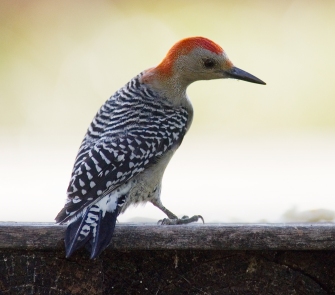|
|
|
|
|||||||||
| Red-bellied Woodpecker | |||||||||
Enjoying Wild Birds in the Lower 48
A Weekly Column from The Birdlady®
|
Red-Topped Woodpeckers Baffle Their Watchers Wintry weather draws a surprising variety of woodpeckers to bird feeders, always an interesting sight with their wood-chisel bills and the stiff tailfeathers that prop them upright on tree trunks. In the eastern half of the U.S., two of the woodpeckers (one common, the other uncommon) cause a lot of confusion: the red-bellied woodpecker and the red-headed woodpecker. Actually it's their names that confuse people, and that's the fault of John James Audubon, the famous bird illustrator who worked in the early 1800s. Both these woodpecker species have a lot of red on their heads, but Audubon dubbed one of them "red-bellied," most likely after he'd shot one-the only way birders and artists could get a close look at birds before binoculars became widely available. Held belly-up in Audubon's hand, the woodpecker's reddish lower belly would have been easy to see-but when a red-bellied woodpecker is perched on your feeder, the only red you're likely to notice is on its head. That's why so many bird enthusiasts mistakenly call these woodpeckers red-headed. The actual red-headed woodpecker is markedly different. A red-bellied woodpecker is flame-red on the top of its head and the back of its neck; a red-headed woodpecker is solid scarlet from beak to shoulders, all the way around. The redbelly has a ladder back, horizontally barred in black and white; the redhead's back is solid black at the top and solid white in the middle, turning black again on the tail. In flight, the redbelly shows a buffy breast and barred wings with very small white wing patches; the redhead flashes a bright white belly and big white wing patches. The distinctions are unmistakable, once you've seen both birds. Unfortunately it's not easy these days to get a look at a red-headed woodpecker. Although red-headed woodpeckers were very common in the 18th and 19th centuries, they have become unusual in most areas now. According to Birds of North America Online, their decline has been attributed to various things including the advent of the automobile (red-headed woodpeckers were often killed in the early days of cars when the birds flew down to pick up insects on the pavement) and the spread of the European starling (which competes with the woodpecker for nest holes). DDT may have been a factor-insects make up at least half of this bird's diet, and the species took a real nosedive between 1940 and 1972, when DDT was being used in the U.S. But habitat destruction is probably the biggest culprit-red-headed woodpeckers like large trees in open groves or scattered in fields. Cut-over and burned-over woods also attract them, and they prefer to dig their nest cavities in old dead trees that have lost their bark. "Progress" has erased many of these habitats. If you're lucky enough to have the right habitat and to see red-headed woodpeckers, you'll probably be able to enjoy them all year. Red-headed woodpeckers don't do much migrating-from the northernmost reaches of their range in Canada and New England, they do fly south, and they also do some wandering in the winter. But chances are that redheads you see in winter won't be far away in summer. To attract both red-bellied and red-headed woodpeckers, provide black oilseed and suet. And here's a caution: Don't put the suet in net onion bags. I used them for years with no trouble-until a reader related the horrifying experience of finding a woodpecker dead, hanging from a net onion bag in which the bird's tongue had become entangled. Now I use only suet feeders built of wood and vinyl-coated wire mesh-and to discourage greedy European starlings, I usually choose upside-down suet feeders. Woodpeckers, chickadees, titmice and brown creepers adapt quickly to the upside-down feeders (they're even quicker to catch on if I tie a bit of suet on a string to dangle beneath the feeder until they notice the suet underneath). Starlings, however, aren't agile enough to hang upside-down for long. © 2009 Frances Hamilton. The Birdlady is a lifelong journalist who has written weekly columns about wild birds since 1968. |

